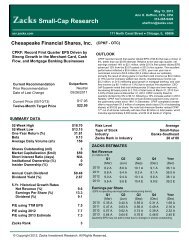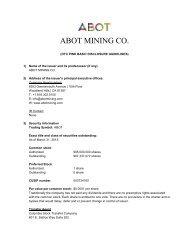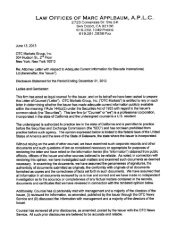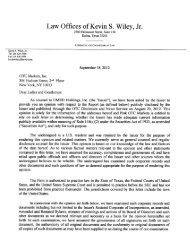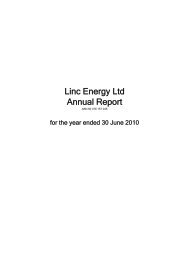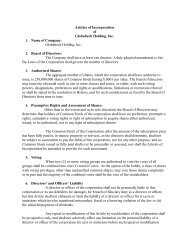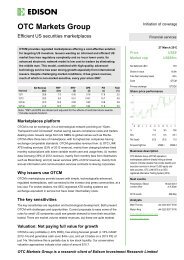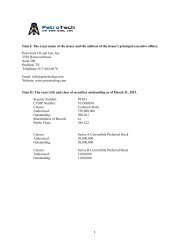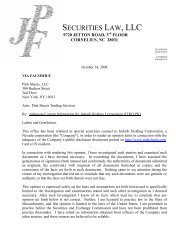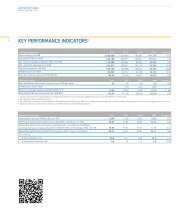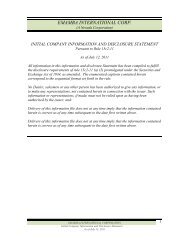2011 Annual Report - OTCIQ.com
2011 Annual Report - OTCIQ.com
2011 Annual Report - OTCIQ.com
You also want an ePaper? Increase the reach of your titles
YUMPU automatically turns print PDFs into web optimized ePapers that Google loves.
182 Corporate Governance <strong>Report</strong><br />
Compensation Plan for Members of the Board of<br />
Management<br />
In accordance with the principles of the version of the Code<br />
dated May 26, 2010, which incorporates VorstAG’s provisions<br />
and in some cases defines them in greater detail, the Supervisory<br />
Board must approve the Executive Committee’s proposal<br />
for the Board of Management’s <strong>com</strong>pensation plan and<br />
reviews the plan regularly.<br />
At its meeting on March 8, <strong>2011</strong>, the Supervisory Board passed<br />
a resolution approving the <strong>com</strong>pensation plan described below.<br />
Components of the Compensation Plan<br />
The <strong>com</strong>pensation of Board of Management members is <strong>com</strong>posed<br />
of a fixed annual base salary paid on a monthly basis,<br />
an annual bonus, and a long-term variable <strong>com</strong>ponent.<br />
These <strong>com</strong>ponents account for approximately the following<br />
percentages of total <strong>com</strong>pensation:<br />
• Base salary 30 percent<br />
• <strong>Annual</strong> target bonus<br />
(with 100% target attainment) 40 percent<br />
• Long-term <strong>com</strong>pensation<br />
(value at issuance) 30 percent<br />
<strong>Annual</strong> Bonus<br />
The annual bonus mechanism for the year under review was<br />
established by a resolution of the Supervisory Board dated<br />
March 8, <strong>2011</strong>, and took effect on January 1, <strong>2011</strong>. Section 87 of<br />
the VorstAG version of the AktG requires that a management<br />
board’s <strong>com</strong>pensation package must be geared towards a sustainable<br />
business performance. To implement this requirement,<br />
the Supervisory Board and Board of Management members<br />
agreed in 2009 that the Board of Management’s annual<br />
bonus mechanism would adopt a multi-year performance metric<br />
effective 2010. This modification affects the <strong>com</strong>pany performance<br />
portion of the annual bonus.<br />
The amount of the bonus is determined by the degree to<br />
which certain performance targets are attained. The targetsetting<br />
system consists of <strong>com</strong>pany performance targets,<br />
individual performance targets, and a value-added factor based<br />
on return on average capital employed (“ROACE”). Board of<br />
Management members who fully attain their performance<br />
target receive the target bonus agreed to in their contracts.<br />
The first step in calculating the total annual bonus is to<br />
determine to what degree the operating-earnings target has<br />
been attained. The second step is for the Supervisory Board, at<br />
its discretion, to determine the degree to which the individualperformance<br />
portion of the annual bonus has been attained.<br />
The third step is for both target-attainment portions to be<br />
weighted (70 percent operating-earnings target, 30 percent for<br />
the individual-performance target) and added together. Finally,<br />
this subtotal is multiplied by a value-added factor.<br />
The metric used for the operating-earnings target is EBITDA.<br />
The EBITDA target for a particular financial year is the plan<br />
figure approved by the Supervisory Board. If E.ON’s actual<br />
EBITDA is equal to the EBITDA target, this constitutes<br />
100-percent attainment. If it is 30 percentage points or more<br />
below the target, this constitutes 0-percent achievement.<br />
If it is 30 percentage points or more above the target, this<br />
constitutes 200-percent attainment. Linear interpolation is<br />
used to translate intermediate EBITDA figures into percentages.<br />
The metric used for the value-added target is ROACE. The<br />
ROACE target is the prior-year weighted-average cost of capital<br />
(“WACC”) plus a premium, stipulated by the Supervisory<br />
Board, to increase leverage. The premium for the <strong>2011</strong> financial<br />
year was 2 percentage points. In view of altered long-term<br />
returns expectations for much of the energy industry and for<br />
E.ON (particularly because of the forced shutdown of some<br />
nuclear power stations in Germany and the altered regulatory<br />
environment), the Supervisory Board resolved to set the<br />
premium at 1.25 percentage points beginning with the 2012<br />
financial year. If E.ON’s actual ROACE is equal to the ROACE<br />
target, this constitutes 100-percent attainment. If it is 2 (effective<br />
2012: 1.25) percentage points or more lower, this constitutes<br />
50-percent attainment. If it is 2 (effective 2012: 1.25) percentage<br />
points or more higher, this constitutes 150-percent<br />
attainment. Linear interpolation is used to translate intermediate<br />
ROACE figures into percentages.<br />
Extraordinary events and changes in E.ON’s portfolio (acquisitions<br />
and disposals of significant assets or government<br />
interventions such as the forced shutdown of some nuclear<br />
power stations in Germany) are not factored into the determination<br />
of target attainment.



